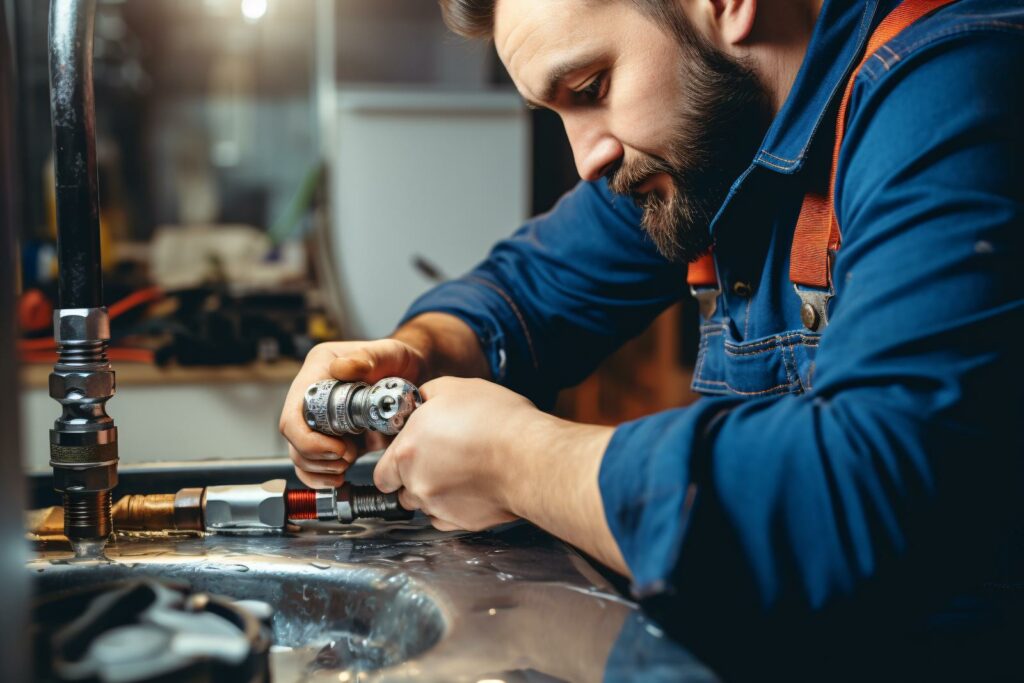
Contents
You might be surprised by the simple yet effective ways to prolong the life of your metal shed. From laying the groundwork right to seasonal maintenance, each step plays an important role in ensuring your shed withstands the test of time. Imagine the peace of mind knowing your shed is well-protected and durable, ready to face whatever the elements throw its way. Let’s explore these seven tips that could make all the difference in the longevity of your metal shed.
Key Takeaways
- Regularly apply rust-inhibiting paint or sealant to prevent corrosion.
- Use galvanized steel or aluminum materials for higher corrosion resistance.
- Implement proper ventilation to prevent moisture buildup.
- Choose effective anchoring methods for stability in extreme weather.
- Apply high-quality paint and sealant for lasting protection against the elements.
Proper Foundation Preparation
To secure the longevity of your metal shed, start by meticulously preparing a solid foundation that will provide stability and support. A concrete slab or a gravel base are excellent options for creating a durable foundation for your shed. A concrete slab offers a permanent and sturdy base, while a gravel base allows for better drainage and is easier to install.
When opting for a concrete slab, make certain that it’s level and properly cured before placing your metal shed on it. Make sure to follow the manufacturer’s recommendations for the thickness of the concrete slab to support the weight of your shed and its contents. Additionally, consider adding a vapor barrier to prevent moisture from seeping into the concrete and causing damage over time.
If you choose a gravel base, start by clearing the area of any vegetation or debris. Then, spread a layer of gravel evenly and compact it to create a solid and level surface. The gravel base provides good drainage and helps prevent water from pooling around your shed, which can lead to rust and corrosion.
Whether you opt for a concrete slab or a gravel base, taking the time to prepare a proper foundation will greatly increase the lifespan of your metal shed. Remember, a strong foundation is the key to a stable and durable structure that will serve you well for years to come.
Regular Inspection and Maintenance
Regularly inspecting and maintaining your metal shed is vital to ensure its longevity and structural integrity. Establishing a consistent inspection schedule will help you catch any issues early on before they escalate. Make it a habit to check for signs of corrosion, loose screws or bolts, dents, and any water damage. By conducting routine inspections, you can address minor problems promptly, preventing them from turning into more significant concerns that could compromise the shed’s stability.
When it comes to repair techniques, having the right tools and materials on hand is essential. Keep a supply of touch-up paint to cover scratches and prevent rust from forming. Tighten any loose fasteners to maintain the shed’s strength and stability. If you notice any dents, consider using a rubber mallet to carefully reshape the metal. For more extensive damage, such as holes or significant rust spots, using metal patches or sealants can help reinforce the affected areas.
In addition to visual inspections, don’t forget to pay attention to the shed’s environment. Trim any overhanging branches that could potentially fall on the shed during a storm. Clear debris from around the shed to prevent water buildup, which can accelerate rusting. By staying proactive with regular inspections and timely repairs, you can maximize the lifespan of your metal shed and ensure it serves you well for years to come.
Rust Prevention Techniques
Implementing effective rust prevention techniques is crucial for extending the lifespan of your metal shed and maintaining its structural integrity. To achieve this, consider applying surface coatings and utilizing materials with high corrosion resistance. Here are some practical tips to help you combat rust and keep your metal shed in top condition:
| Rust Prevention Techniques | Details |
|---|---|
| 1. Surface Coatings | – Regularly apply rust-inhibiting paint or sealant to create a protective barrier against moisture and oxidation. |
| 2. Corrosion Resistance | – Opt for galvanized steel or aluminum materials that have natural corrosion resistance properties. Make sure proper installation is done to avoid scratches that expose the base metal. |
Adequate Ventilation Strategies
To guarantee the longevity of your metal shed, consider the strategic placement of vents to facilitate proper air circulation.
Explore various ventilation system options to find the most suitable one for your shed’s needs.
Regular maintenance of these vents is essential in preventing moisture buildup and rust formation.
Vent Placement Importance
Ensuring the correct placement of vents is vital for maximizing the lifespan of your metal shed and maintaining ideal ventilation levels. Proper ventilation positioning promotes good air circulation, preventing the buildup of moisture and humidity that can lead to rust and corrosion. Additionally, weatherproofing vents are essential for moisture control, keeping your shed dry and free from damage caused by water infiltration. Here are some practical tips to optimize vent placement:
| Tip | Description | Benefit |
|---|---|---|
| Position High | Place vents near the roof to allow hot air to escape easily | Prevents condensation and heat buildup |
| Balance Placement | Ensure vents are evenly distributed for uniform airflow | Reduces the risk of moisture accumulation |
| Use Weather Covers | Install weatherproof covers to shield vents from rain | Protects against water damage and rust |
Ventilation System Types
Properly selecting and implementing a suitable ventilation system is crucial in effectively managing airflow within your metal shed to prevent rust and corrosion.
When considering ventilation system types, you have two main options: natural ventilation and mechanical ventilation. Natural ventilation relies on openings like windows, vents, or ridge caps to allow air to flow through the shed. This method is cost-effective and environmentally friendly but may not always guarantee consistent airflow.
On the other hand, mechanical ventilation uses fans or exhaust systems to actively circulate air. While this option guarantees more controlled airflow, it can be more expensive to install and operate.
Understanding the pros and cons of each ventilation type will help you make an informed decision based on your specific needs.
Maintenance for Vents
Regular inspection and cleaning of vents is essential to ensure proper airflow and prevent the buildup of debris in your metal shed. Vent cleaning should be on your maintenance checklist to promote excellent airflow management.
Start by removing any dirt, leaves, or other obstructions from the vents using a brush or a vacuum cleaner. Check for any signs of rust, corrosion, or damage that could hinder ventilation and address them promptly.
Excellent airflow management is vital for regulating temperature and humidity levels inside the shed, preventing mold and mildew growth. By incorporating regular vent cleaning into your shed maintenance routine, you can prolong the lifespan of your metal shed and create a healthier environment for your belongings.
Secure Anchoring Methods
For maximum durability of your metal shed, it’s imperative to implement effective anchoring methods that ensure stability and resilience in various weather conditions. Proper anchoring guarantees that your shed can withstand strong winds and other external forces that may otherwise damage or displace it. Here are some key tips to help you secure your metal shed effectively:
Auger Anchors: These corkscrew-like anchors are excellent for securing sheds to the ground. They provide strong support and are ideal for areas prone to high winds.
Concrete Anchors: Using concrete anchors involves drilling into a concrete base to secure your shed. This method offers exceptional stability and is highly recommended for areas with extreme weather conditions.
Mobile Home Anchors: These anchors are typically used for mobile homes but can also be effective for metal sheds. They’re driven into the ground at an angle to provide strong resistance against wind uplift.
Strap and Tension Anchors: Securing straps attached to the shed and anchored deep into the ground can significantly enhance stability. Tension anchors help distribute weight evenly, preventing the shed from shifting during storms.
Paint and Sealant Applications
To ensure the long-term durability of your metal shed, establishing a proper regimen for paint and sealant applications is essential. When it comes to painting a metal shed, the first step is selecting the right primer. Choose a high-quality primer that’s specifically formulated for metal surfaces. This primer will help the paint adhere better to the metal, creating a strong bond that enhances the shed’s protection against the elements.
When selecting paint for your metal shed, opt for a weather-resistant acrylic or enamel paint. These types of paint provide a durable finish that can withstand harsh weather conditions, preventing rust and corrosion. Make sure to apply the paint evenly, following the manufacturer’s instructions for the best results.
After painting your metal shed, sealing it with a weather-resistant sealant is essential. The sealant acts as an additional layer of protection, guarding the paint against UV rays, moisture, and other environmental factors that can cause damage over time. Regularly inspect the sealant for any signs of wear and tear, and reapply it as needed to maintain optimal protection.
Seasonal Care and Protection
Consider implementing a seasonal maintenance schedule to safeguard your metal shed against changing weather conditions and prolong its lifespan. By following a structured approach throughout the year, you can guarantee that your shed remains in top condition regardless of the season. Here are some key tips to help you protect your metal shed:
Winter weatherization: Before the cold sets in, make sure to weatherize your shed by checking for any gaps or leaks where cold air and moisture can seep in. Apply a fresh coat of weather-resistant paint to prevent rust and corrosion during the winter months.
Summer sun protection: Shield your metal shed from the harsh rays of the sun by applying a UV-resistant sealant or paint. This won’t only prevent the paint from fading but also protect the metal from heat damage.
Snow load prevention: Clear off any accumulated snow from the roof of your shed to prevent overloading. Use a snow rake or a broom to carefully remove the snow without damaging the roof panels.
Rainwater drainage: Ensure that your shed has proper drainage to prevent water buildup, which can lead to rust and deterioration. Clean out the gutters regularly and make sure that the surrounding area allows for proper water runoff.
Final Thoughts
By following these seven tips, you’ve discovered the secret to extending the lifespan of your metal shed.
With a solid foundation, regular maintenance, rust prevention, ventilation, secure anchoring, paint, sealant applications, and seasonal care, your shed is built to withstand the test of time.
Embrace the power of these strategies and watch your metal shed thrive for years.
Keep up the good work, shed enthusiasts!
Recent Posts
3 Tips for Personalized Metal Garage Solutions
Finding personalized metal garage solutions can transform your cluttered space into a functional haven. By
Guide to Lasting Metal Structures for Homes
Imagine a sturdy metal garage standing proud against the fiercest storms, much like a lighthouse
What Are Affordable Metal Garage Options for Farms?
Imagine you’re managing a bustling farm like Smith’s Acres, where every inch of space counts.




